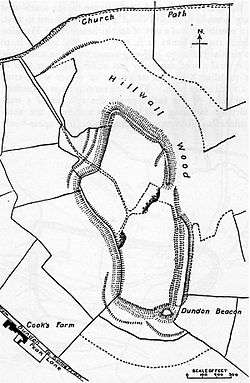Dundon Hill Hillfort
| Dundon Hill Hillfort | |
|---|---|
|
Plan of the site | |
| Location | Compton Dundon, Somerset, England |
| Coordinates | 51°05′13″N 2°44′13″W / 51.08694°N 2.73694°WCoordinates: 51°05′13″N 2°44′13″W / 51.08694°N 2.73694°W |
| Built | Iron Age |
| Designated | 1996[1] |
| Reference no. | 22076[2] |
 Location of Dundon Hill Hillfort in Somerset | |
Dundon Hill Hillfort is an Iron Age hillfort in Compton Dundon, Somerset, England. It has been designated as a Scheduled Ancient Monument.[2] South east of the site is a Bronze Age bowl barrow which, it has been suggested, was later modified as a Norman Motte, known as Dundon Beacon.[3]
The 5 hectares (12 acres) site is guarded by a single bank ranging from .5 metres (1.6 ft) to 2.5 metres (8.2 ft) high, however parts of the site have been damaged by quarrying.[2] Flint flakes, Bronze Age pottery, and Iron Age pottery have also been found, which are now in the Museum of Somerset.[1]
Dundon Hill, also sometimes called Dundon Beacon, stands out prominently in the flat country of King's Sedgemoor, rising to a height of 270 feet. One writer on ancient earthworks notes that it "looks like a respectable mountain and is in fact a natural island fortress". The whole of the hilltop is enclosed by the single bank of stones and earth.[4]
See also
References
- 1 2 "Dundon Hill". Pastscape. English Heritage. Retrieved 2 February 2011.
- 1 2 3 "Dundon Hillfort, Compton Dundon". Historic Environment Record. Somerset County Council. Retrieved 27 December 2010.
- ↑ "Dundon Beacon". Pastscape. English Heritage. Retrieved 2 February 2011.
- ↑ Edward J. Burrow, Ancient earthworks & camps of Somerset (1924), p. 84
